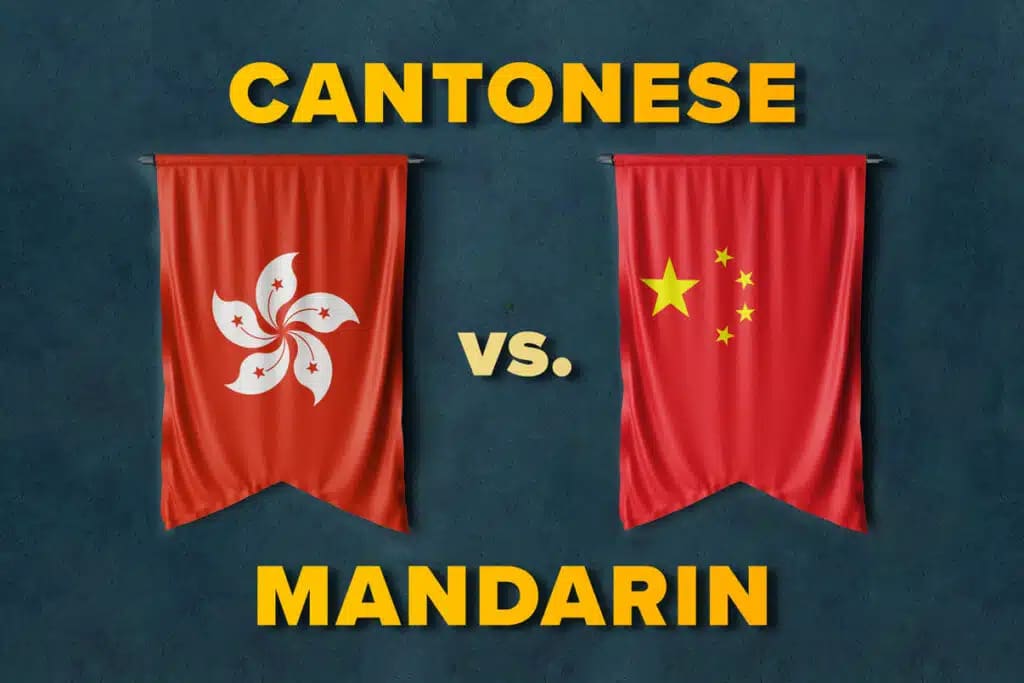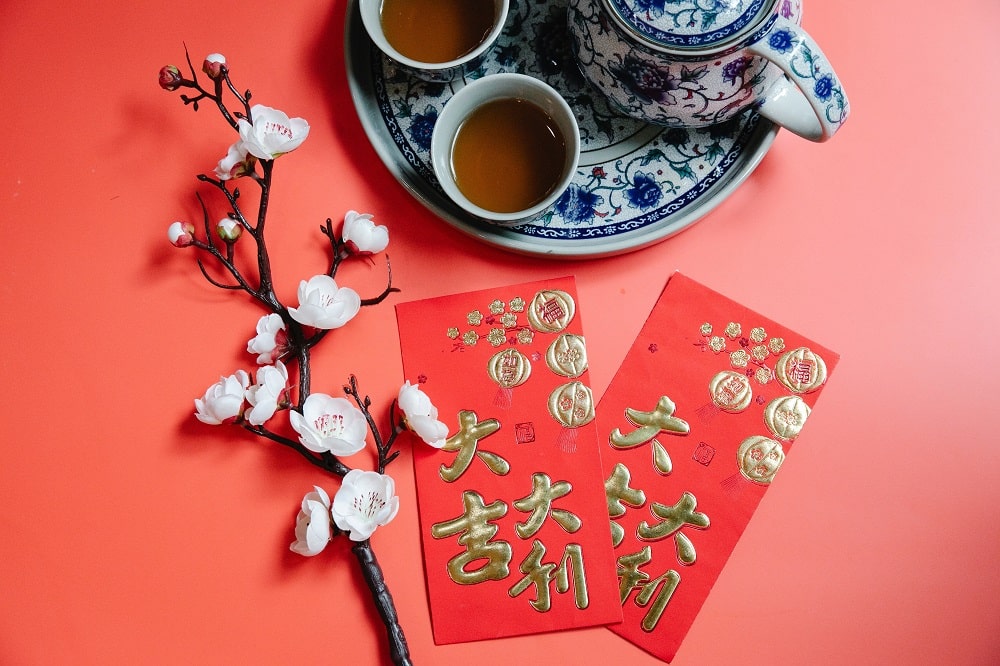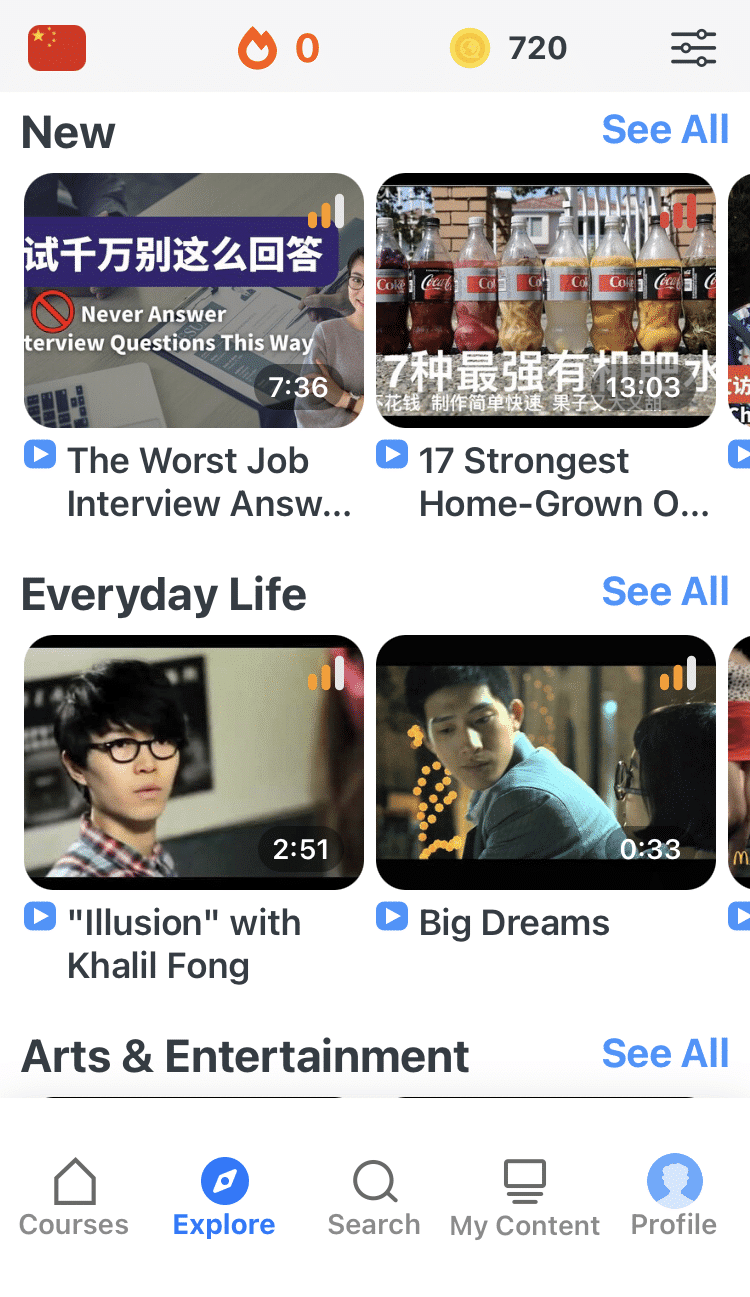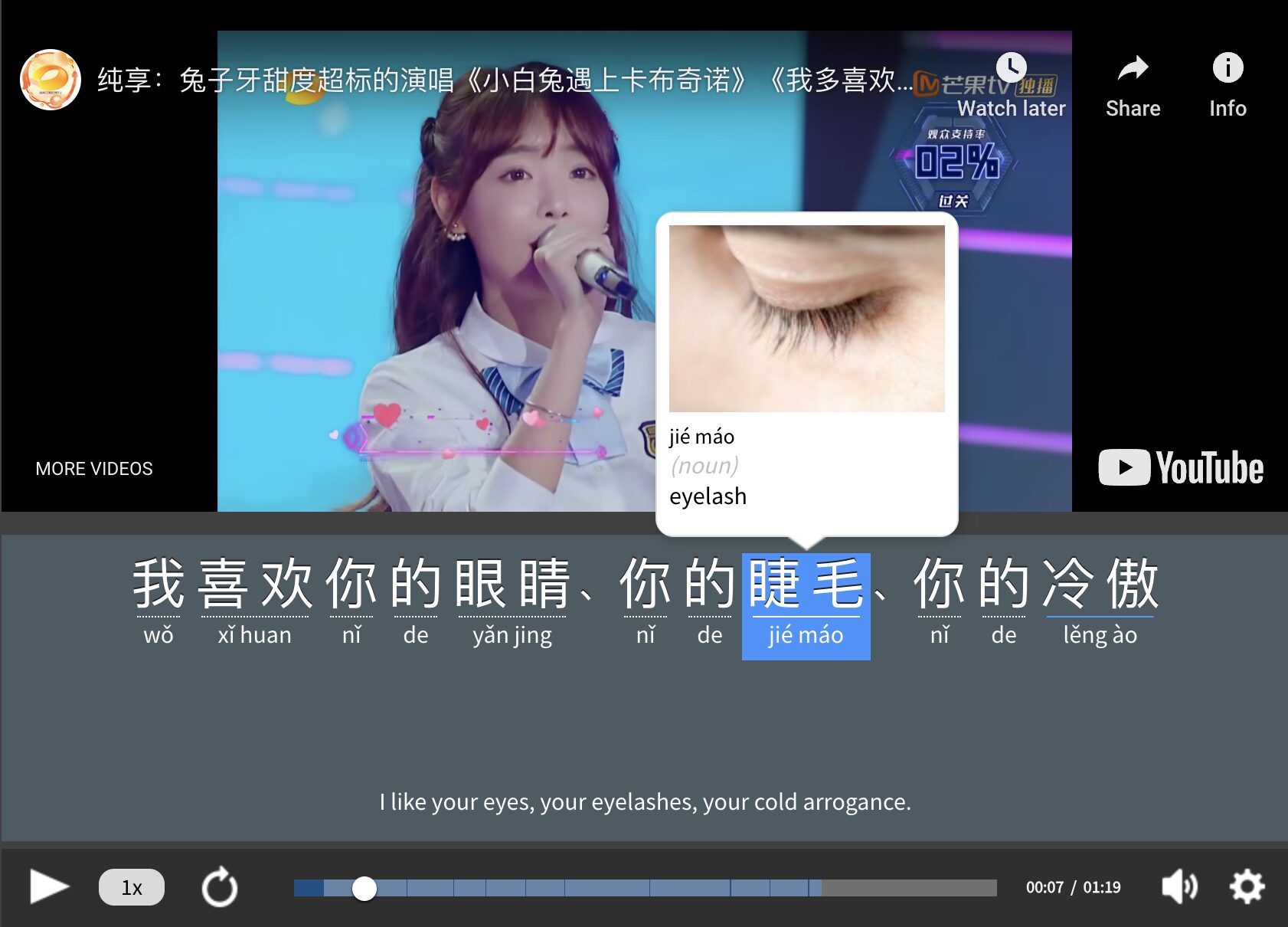Contents
- Chinese Language vs. Chinese Dialect
- Cantonese vs. Mandarin at a Glance
- What Are the Differences in Tones?
- What Are the Differences in Vocabulary and Grammar?
- Where Is Cantonese Spoken?
- Where Is Mandarin Spoken?
- Simplified vs. Traditional Characters
- The Romanization Systems
- Learning Mandarin vs. Cantonese
- And one more thing...
Cantonese vs. Mandarin: 5 Key Differences

There are hundreds of Chinese dialects, but most people opt to learn the two most commonly spoken, which are Mandarin and Cantonese. So how does one choose between the two?
Discover the differences between these two beautiful dialects in the post below so you can have all of your Cantonese vs. Mandarin questions answered.
Download: This blog post is available as a convenient and portable PDF that you can take anywhere. Click here to get a copy. (Download)
Chinese Language vs. Chinese Dialect
While there has been an ongoing linguistic debate regarding the distinction between a language and a dialect, you can think of the difference between language and dialect as the following:
Language is considered an umbrella term that includes dialects or variations of the language. Dialects are generally mutually intelligible, though there are many exceptions to this rule.
In the case of Chinese, Chinese is a language, while Mandarin and Cantonese are considered dialects. The dialects are not mutually intelligible when spoken, but written Chinese can be understood by speakers of all dialects.
Therefore, the Chinese language (in a general sense) exists in written form and can be more or less understood by speakers of any Chinese dialect.
For example, if a Cantonese speaker spoke to a Mandarin speaker, they wouldn’t be able to understand each other’s spoken language. However, if the Cantonese speaker wrote down what they wanted to say, the Mandarin speaker would likely be able to understand the written form.
Cantonese vs. Mandarin at a Glance
Cantonese and Mandarin are two of the most commonly used dialects in China.
As a result, they’re the two most studied Chinese languages. Both Mandarin and Cantonese are also among the best languages to learn for business because of how commonly they’re spoken in certain parts of Asia.
Knowing the difference between the two, as well as where and by whom each one is used will help you choose the one that’s best suited to your specific language goals and needs.
So, let’s look at some of the main differences between Cantonese and Mandarin:
- Colloquial spoken Cantonese differs from colloquial spoken Mandarin—Cantonese has 9 tones, while Mandarin has four (or five).
- Cantonese and Mandarin don’t have the same vocabulary and grammar. Being fluent in one dialect doesn’t mean you’ll understand the other.
- People in Mainland China, Taiwan and Singapore speak Mandarin, while those in Hong Kong and Guangdong province speak Cantonese.
- Mandarin uses simplified Chinese characters while Cantonese uses traditional Chinese characters.
- Cantonese uses the Jyutping romanization system while Mandarin uses Pinyin.
What Are the Differences in Tones?
Chinese is infamous for being a tonal language—meaning the tone, or pitch of the word determines its meaning. Not surprisingly, tones have a tendency to scare people away from learning Chinese because they’re commonly deemed too difficult to learn.
But Cantonese and Mandarin aren’t the only Chinese dialects with a tonal system.
In fact, every Chinese dialect has a tonal system.
The difference between the two tonal systems, however, is the number of tones each dialect uses.
Mandarin consists of four major tones, but some linguists count the neutral tone as a fifth.
| Tone | Description | Example |
|---|---|---|
| 1st | High and flat | 妈 (mā) — mother |
| 2nd | Rising, like asking a question | 麻 (má) — hemp |
| 3rd | Falling then rising | 马 (mǎ) — horse |
| 4th | Sharp and falling | 骂 (mà) — scold |
| Neutral | Light and quick | 吗 (ma) — [question particle] |
Cantonese, on the other hand, has six major tones:
| Tone | Example |
|---|---|
| High flat | 詩 (si1) — poem |
| High rising | 史 (si2) — history |
| Mid flat | 試 (si3) — to try |
| Low falling | 時 (si4) — time |
| Low rising | 市 (si5) — market |
| Low flat | 事 (si6) — matter |
Aside from this, it has three additional high, mid and low-level tones used with syllables ending in -p, -t or -k. Together, that comes out to a whopping nine tones—four more than Mandarin!
What Are the Differences in Vocabulary and Grammar?
It’s no surprise that Cantonese and Mandarin adhere to their own set of grammar rules and vocabulary.
After all, they’re two different dialects.
Cantonese and Mandarin are mutually unintelligible—meaning, the speaker of one can’t understand the other.
Keep in mind, though, that Mandarin is the official language of China, meaning even Cantonese speakers are required to learn Mandarin in school. You can even find Mandarin learning programs in Hong Kong, where Cantonese is the main dialect.
Thus, most Cantonese speakers can understand Mandarin. But not many Mandarin speakers know Cantonese.
Vocabulary
Let’s take a look at some examples of different Cantonese and Mandarin vocabulary words.
Cantonese Vocabulary Examples
你好 (néih hóu) — Hello
好耐冇见 (hóunoih móuhgin) — Long time no see
你叫做乜野名呀? (néih giu jouh mātyéh méng a?) — What’s your name?
你係邊度人呀? (néih haih bīndouh yàhn a?) — Where are you from?
Mandarin Vocabulary Examples
你好 (nǐ hǎo) — Hello
好久不见 (hǎo jiǔ bú jiàn) — Long time no see
你叫什么名字? (nǐ jiào shénme míngzi?) — What’s your name?
你是哪国人? (nǐ shì nǎ guó rén?) — Where are you from?
If you want to learn a few more expressions and differences between Cantonese and Mandarin, check out this fun video from Off the Great Wall!
Grammar
Mandarin and Cantonese grammar actually have a lot of similarities! Both usually follow a subject-verb-object structure like English, and they also both use measure words.
However, there are still some differences, especially in the spoken language.
Cantonese tends to be more flexible when it comes to word order:
- In Mandarin, the indirect object comes before the direct object:
我给我的朋友一本书 (wǒ gěi wǒ de péngyǒu yì běn shū) — I give my friend a book.
- Cantonese also generally follows this, but sometimes the direct object comes first:
我畀本書我個朋友 (ngóh béi bún syū ngóh go pàhngyáuh) — I give a book to my friend.
Another difference is Cantonese uses the passive form less than Mandarin and requires an agent:
- In Mandarin, you can say:
文件被偷了 (wénjiàn bèi tōu le) — The documents were stolen.
- But in Cantonese, you have to include the doer of the action:
文件俾人偷咗 (màhngín béi yàhn tāu jó) — The documents were stolen by someone.
Where Is Cantonese Spoken?
Cantonese is spoken in Hong Kong, Macau and Guangdong.
Unlike Mandarin, Cantonese isn’t spoken or understood throughout all of China.
But that doesn’t take away from the fact that it’s spoken by more than 70 million people.
Plus, it’s used in some of China’s most populated and tourist-attractive regions.
According to WorldAtlas, Cantonese is most commonly spoken in Hong Kong and the Guangdong Province, where it’s recognized as the lingua franca—the common language, but not necessarily the native language. It’s also spoken in Malaysia and Macau.
Like with Mandarin, there’s plenty of Cantonese media out there ready for enthusiastic learners to consume. The internet is full of Cantonese music, TV shows and other kinds of captivating content.
As with learning any language, learning Cantonese will allow you to connect on a deeper level with native Cantonese speakers.
Where Is Mandarin Spoken?
It’s no surprise that most Chinese learners choose to study Mandarin. It’s what most people automatically think of when they hear or say “Chinese.”
It’s also the most commonly spoken dialect in China, as well as the official language of Singapore and Taiwan.
While there are a few regional varieties of Mandarin, all of them are understandable to any Mandarin speaker.
Since Mandarin is the official language of three countries, it’s also the language used in most Chinese movies, TV programs and music.
Whether you’re studying Mandarin long-term or doing intensive immersion, you’ll need a lot of exposure and listening comprehension practice to identify different Mandarin varieties from one another, as well as to understand them.
One resource for this would be the FluentU program.
FluentU takes authentic videos—like music videos, movie trailers, news and inspiring talks—and turns them into personalized language learning lessons.
You can try FluentU for free for 2 weeks. Check out the website or download the iOS app or Android app.
P.S. Click here to take advantage of our current sale! (Expires at the end of this month.)
Simplified vs. Traditional Characters
There are two different Chinese writing systems: simplified and traditional Chinese.
I won’t go too deep into the history of each, but basically, traditional Chinese was the most commonly used writing system for centuries until the 1950s and 60s.
In 1949, the Chinese government declared simplified Chinese to be the new common writing system in order to reform the nation.
But that doesn’t mean there aren’t a lot of people (or places) still using traditional characters today.
Cantonese speakers primarily use traditional characters. It’s the most commonly used writing system in Hong Kong, Singapore, Malaysia and Taiwan.
Mandarin, on the other hand, uses simplified characters.
But similar to many Chinese dialects, traditional and simplified characters are recognizable and fairly easy to read regardless of which system a person uses the most.
For example, native Mandarin speakers in China can read most traditional characters and vice versa.
Examples of Simplified Characters
我爱你 (wǒ ài nǐ) — I love you
我喜欢学中文 (wǒ xǐ huān xué zhōng wén) — I like studying Chinese
我是美国人 (wǒ shì měi guó rén) — I am American
Examples of Traditional Characters
我愛你 (wǒ ài nǐ) — I love you
我喜歡學中文 (wǒ xǐ huān xué zhōng wén) — I like studying Chinese
我是美國人 (wǒ shì měi guó rén) — I am American
The Romanization Systems
Pinyin
If you’re learning Mandarin, pinyin is a lifesaver.
It’s the romanization system for Mandarin words and tones that tells learners how to pronounce them.
However, it wasn’t created for that purpose.
In the 1950s, pinyin was invented to help improve literacy rates in China.
Examples of Pinyin
As we previously established, pinyin is the spelling of Chinese words with English letters.
If you haven’t already noticed, pinyin is the English spelling we put in parentheses and italics in our FluentU Chinese blogs.
For example:
我喜歡學中文 (wǒ xǐ huān xué zhōng wén) — I like studying Chinese
Did you spot the pinyin?
wǒ xǐ huān xué zhōng wén is the perfect example of what pinyin looks like.
Jyutping
Did you know, though, that Cantonese also has its own romanization system? It’s called Jyutping.
Just like pinyin, Jyutping uses the Latin alphabet to spell out Cantonese words and uses marks and numbers to symbolize tones.
There are three types of Jyutping: Yale, Sidney Lau and LSHK Jyutping.
- Yale Jyutping uses diacritics to mark tones (like pinyin) and is the most commonly used type.
- Sidney Lau Jyutping uses numbers to mark tones (eg. neih2 hou2) and used to be the most common type. It’s not as popular nowadays but it’s still used by many older textbooks.
- LSHK Jyutping is very similar to Sidney Lau as it uses numbers to mark the tones. However, it also includes a few refinements to certain pronunciations. It’s the newest type of jyutping and is being promoted and recommended by the Linguistic Society of Hong Kong.
Examples of Jyutping
Let’s take a look at the two most commonly used Jyutping systems in Cantonese:
Yale Jyutping:
你叫做乜野名呀?
(néih giu jouh mātyéh méng a?) — What’s your name?
Sidney Lau Jyutping:
你叫做乜野名呀?
(neih2 giu jouh ma1tyeh2 meng2 a?) — What’s your name?
Once again, you can spot the Jyutping by noticing the difference in tone marks and by the italics.
Learning Mandarin vs. Cantonese
Now that you know all about the basic differences between Mandarin and Cantonese, which one should you learn?
Mandarin is usually the more practical choice because it’s widely spoken, with more than a billion speakers. Since it’s the lingua franca among Chinese dialects, most Cantonese speakers know Mandarin.
There are a ton of learning resources available in Mandarin, plus the pronunciation is easier to learn than Cantonese because it has fewer tones.
On the other hand, if you’re planning to stay in Guangdong, Hong Kong or Macau or do business with companies there, Cantonese can be a helpful dialect.
It’s also great for those fascinated with Hong Kong culture (there are a lot of amazing films from Hong Kong!) or those whose ancestors spoke Cantonese and want to reconnect with their heritage.
Of course, you can learn both. There’s a lot of overlap with grammar and most characters have the same meaning—it’s similar to learning two Romance languages.
So, what will it be now—Mandarin or Cantonese?
Remember to consider where you’re planning on using your newly acquired language skills and with whom you want to communicate!
Download: This blog post is available as a convenient and portable PDF that you can take anywhere. Click here to get a copy. (Download)
And one more thing...
If you like learning Chinese at your own pace and from the comfort of your device, I have to tell you about FluentU.
FluentU makes it easier (and more fun) to learn Chinese by making real content like movies and series accessible to learners. You can check out FluentU's curated video library, or bring our learning tools directly to Netflix or YouTube with the FluentU Chrome extension.
One of the features I find most helpful is the interactive captions—you can tap on any word to see its meaning, an image, pronunciation, and other examples from different contexts. It’s a great way to pick up vocab without having to pause and look things up separately.
FluentU also helps reinforce what you’ve learned with personalized quizzes. You can swipe through extra examples and complete engaging exercises that adapt to your progress. You'll get extra practice with the words you find more challenging and even be reminded you when it’s time to review!
You can use FluentU on your computer, tablet, or phone with our app for Apple or Android devices. Click here to take advantage of our current sale! (Expires at the end of this month.)















